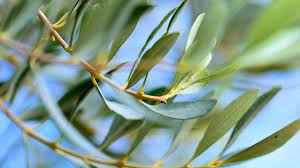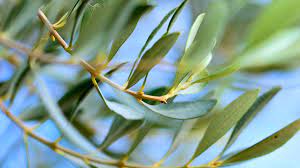Olive leaves are the leaves of the olive tree (Olea europaea), a species native to the Mediterranean region but now cultivated worldwide for its fruit and oil. Olive leaves are typically oblong or elliptical in shape, with a pointed apex and a rounded or tapered base. They are generally 4-10 cm long and 1-3 cm wide, depending on the specific variety of the olive tree. The leaves have a smooth surface and are usually a grayish-green color on the upper side, while the lower side is silver-green due to a dense layer of fine hairs.
Olives leaves have a leathery texture, which makes them resilient and resistant to harsh weather conditions. The surface of the leaf is smooth to the touch on the upper side, while the lower side may feel slightly softer due to the fine hairs.
When crushed or bruised, olives leaves emit a distinct aromatic scent that is often described as a mild, pleasant herbal aroma. The scent can vary slightly based on factors such as the age of the leaves and the specific variety of the olive tree.
Olives leaves are known for their potential health benefits, including antimicrobial, antioxidant, anti-inflammatory, and immune-boosting properties. They contain compounds such as oleuropein, which is believed to have significant health-promoting effects.
Olive leaves have been used for centuries in traditional Mediterranean medicine for their healing properties. In some cultures, olive leaves are used to make herbal teas, extracts, or supplements for their potential health benefits. However, it’s important to note that consuming olive leaves or products made from them should be done in moderation and under appropriate guidance.
Olive leaves have symbolic importance in various cultures and are often associated with peace, wisdom, and victory. In ancient times, olive leaves were used to create wreaths for victors in athletic competitions and wars, symbolizing triumph and honor.
Olive leaves are classified as part of the Oleaceae family, which includes flowering plants like jasmine and lilac. The botanical name for the olive tree is Olea europaea. Olive leaves are an integral part of the olive tree, contributing to both its visual appeal and its valuable role in traditional medicine and culture.
The Economic Importance and Uses of Olive Leaves

Olive leaves have several economic and practical uses, ranging from traditional medicine to potential applications in various industries.
Here are some of the economic importance and uses of olive leaves:
1. Traditional Medicine: Olive leaves have been used for centuries in traditional medicine due to their potential health benefits. They are known to have antioxidant and anti-inflammatory properties, and may help manage various health conditions, including hypertension, diabetes, and infections.
2. Pharmaceutical Industry: Extracts from olives leaves, particularly oleuropein, are used in the pharmaceutical industry for producing supplements and medicines. Oleuropein has been studied for its potential in treating high blood pressure, cardiovascular diseases, and as an antiviral agent.
3. Dietary Supplements: Olives leaf extracts are often used to create dietary supplements, which are marketed for their potential health benefits, including boosting the immune system and improving overall well-being. These supplements are available in various forms such as capsules, tinctures, or teas.
4. Cosmetic and Skincare Products: Olive leaf extracts are used in the cosmetic and skincare industry for their antioxidant properties and potential to improve skin health. They are incorporated into creams, lotions, and serums to help hydrate the skin, reduce signs of aging, and protect against free radicals.
5. Food Industry: Olive leaves are utilized in the food industry to enhance food products. They can be used in teas, as a flavoring agent, or as an ingredient in certain dishes. Olive leaf extract can also be used to extend the shelf life of certain food products due to its antimicrobial properties.
Read Also: Olive Fruit: Economic Importance, Uses And By-Products
6. Agriculture and Livestock: Olive leaves can be used as a natural fertilizer or mulch in agricultural settings. They can enrich the soil with nutrients as they decompose, promoting healthy plant growth. Additionally, some farmers use olive leaves as feed for livestock, particularly in Mediterranean regions.
7. Eco-Friendly Products: Olive leaves can be used to produce eco-friendly and sustainable products, such as biodegradable packaging materials or natural cleaning products, due to their abundance and natural properties.
8. Textile Industry: Olives leaves contain tannins, which can be used for natural dyeing of textiles. Tannins can produce a range of colors, from light yellow to dark brown, and can be used as a sustainable alternative to synthetic dyes.
9. Ornamental and Decorative Purposes: Olivse leaves and branches are used for decorative purposes, such as in floral arrangements and wreaths. Olive branches, symbolic of peace and victory, are often used in ceremonies, events, and religious rituals.
10. Research and Development: Olive leaves are a subject of ongoing research to discover new potential applications and benefits. Research in biotechnology, pharmaceuticals, and agricultural sectors may lead to further commercial uses of olive leaves.
The Products and By-products That Can Be Derived From Olive Leaves

Olive leaves, a byproduct of olive cultivation, have gained attention due to their potential health benefits and the presence of various compounds.
Here are some products and by-products that can be derived from olive leaves:
1. Olive Leaf Extract (OLE): Olive leaf extract is a concentrated liquid or powder made from the leaves of the olive tree. It contains compounds such as oleuropein, which has antioxidant, anti-inflammatory, and antimicrobial properties. OLE is used in dietary supplements and natural health products.
2. Olive Leaf Tea: Dried olives leaves can be used to make tea, which is known for its potential health benefits, including supporting the immune system and promoting overall well-being.
3. Olive Leaf Infusions: Olives leaves can be infused in oils, vinegar, or alcohol to extract their beneficial compounds. These infusions can be used in cooking, skincare products, or as natural remedies.
4. Olive Leaf Powder: Dried and ground olive leaves can be used to create a fine powder. This powder can be used in dietary supplements, food products, or as an ingredient in skincare and cosmetic formulations.
5. Olive Leaf Capsules or Tablets: Olive leaf extract can be encapsulated or compressed into tablets for easy consumption as a dietary supplement. These forms are convenient and commonly used to deliver the health benefits of olive leaves.
6. Olive Leaf Tincture: An alcohol-based liquid extract made from olive leaves, used for its potential medicinal properties. Tinctures are often used for their concentrated and easily absorbed form.
7. Olive Leaf Oil: Olive leaf oil can be extracted from the leaves and used in cooking, similar to olive oil. It may have a different flavor profile and potential health benefits due to its unique composition.
8. Olive Leaf in Skincare Products: Extracts, infusions, or powders derived from olive leaves are used in skincare products such as creams, lotions, and serums for their antioxidant and anti-inflammatory properties, promoting healthy skin.
9. Animal Feed Supplements: Dried and ground olive leaves can be used as a component in animal feed, providing potential health benefits to livestock due to the presence of bioactive compounds.
10. Compost and Fertilizer: Olive leaves can be composted and used as organic matter to improve soil fertility and structure, acting as a natural fertilizer for plants.
11. Natural Dyes: Olive leaves can be used to create natural dyes for textiles and crafts. The leaves contain compounds that can impart various shades of yellow or green to fabrics.
12. Olive Leaf Mulch: Dried olive leaves can be used as a natural mulch in gardening and landscaping, helping to retain moisture, suppress weeds, and improve soil health.
In conclusion, utilizing olive leaves and their by-products not only maximizes the potential benefits from the tree but also supports sustainable practices and minimizes waste in the olive cultivation industry.
Read Also: How to Make Money from Glass Wastes

